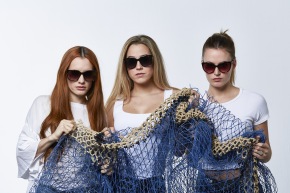NEWS
29 Jul 2020
What inspired you to create a Cradle-to-Cradle accredited range of eyewear?
Well, there are two questions in there.
Why eyewear, the optical sector is a hundred-billion-dollar industry and sustainability is non-existing, at least when I started. When I was following projects where people were collecting marine plastic and companies using recycled yarns to produce fabrics and clothes. And I have been on conferences about ocean plastic, plastic and plastic pollution and production and I was starting to wear glasses, and one day I realised maybe we can do one thing with the other so we started to teamed up with fishing communities here, then in France and now in Africa. Seeing how we can use this recycled raw material to produce something that would make sense, something that people can wear, something that would make consumers part of what we are doing. Consumer belonging to what we are doing, and one day I started to wear glasses and I thought that it was made of plastic so maybe we can do something, and this is now this all started glasses.
Why Cradle-to-Cradle:
Very simple, it is a great guarantee about first of the quality material and the way it is being recycled. A certification that puts no doubt the recycled material and its raw material. We are the only eyewear brand that has the c2c certification, we have the gold level which is amazing. So again why, very simple, C-2-C is the most rigorous certification in terms of circular economy and that is why we selected them to certify our raw material.
What were the main challenges you faced in order to get it launched; and are you still facing these challenges today?
The main challenges we faced when we launched and we are still facing these today is the collection of mixed waste, the first thing you learn is that polymers have to be properly separated and selected before being recycled because polymers are all different. The second challenge was to identify the best polymer that we could use to manufacture our glasses. The third ones was to once we identified them to face the technicalities to make the material more dense or less dense, play with the elements within the manufacturing process; to make sure that we have a product that pleases the customer because the story is very good, but the quality of the product is key. The story on its own is not enough. Since we are competing with other brands, we need to have a product that is on par or even better. The truth is that because of the nature of the product, the DNA of our story and our product, as well as the fact that is its made of 100% up-cycled waste, the market and the consumers and obviously the opticians are checking the product with much more attention than any other brands. This is always a challenge.
What were the most memorable, defying moments during this time?
If you believe in something, the progression that we had was quite fast. We hit the first optical store in January 2017, and we have passed over 3,000 optical stores today. That is memorable. Having Famous brands collaborating with us is obviously something that is always an achievement, it gives creditability to the product having famous artists relying on your products or your story and getting involved is always an achievement. Having all these retailers and optician spreading our value is always an achievement, At the end of the day it is a people effort. We are eco disrupting this optical industry with a product, that is initially made of trash. Looking at the way this product is being accepted in the market and hundreds of thousands of people wearing it make us believe that we did a good job.
What helped you to see it through to the end?
You never see it initially, but we did a crowd funding to finance the first steps of the project.
I was broke and did not have the money to finance it, so we did a crowd funding and it worked. That was the first creditable aspect that motivated us to go, so we could cover the cost of producing the first real sun glass collection and thanks to that we got into the first store and one thing led to another. You do not see the end. What you do is to work day by day and focus on your core value, which is obviously the WHY and not the WHAT. There is still so much to be done, people to seduce with what we do. Anyone wearing a Sea2see becomes an ambassador of change.
The end…..looking at the state of the planet, we still have a lot of work to do.
What are your plans for the next 5 years?
The plan for the next years is deploying in more countries, such as Africa and Asia. We already have a social enterprise in Ghana and Senegal. Because of these social enterprises, people living in coastal communities have access to a new source of income; thanks to the amount of waste and plastic they collect. In terms of retail we want to grow in the optical word. We also plan to open a recycling plant hopefully starting construction before the end of 2020, that if all the financial aspects are solved. We are talking to investors teaming up with people that understand our values. We are also launching a new product during summer, which are watches, with the same principle using our recycled raw material and Made-in-Switzerland combining a sustainable story and the quality of watchmaking in Switzerland.



